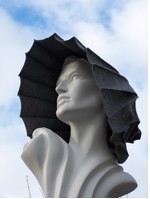I had been hoping to make it to the Barbican before this closed and thankfully did and had delightful company (thanks Ags) too, who was inciteful, critical and had some great new ideas. Again no photos...just the £35 book to buy which was a shame, as it is such a big exhibition with so much happening and things that have been brought together that you wouldn't normally see that you need to be able to reflect again afterwards.
Illicit photos were taken.
It is a huge space and it was well designed in many respects to get across the exquisiteness of the work. I would have liked to have had more references of what the 80's fashion that the Japanese aesthetic was so far removed from was like. I obviously remember it well yet for someone in their twenties I think it is harder to fully grasp how truly revolutionary and visionary the designers were, and personally I feel that this hasn't happened again. The exciting designers that have come to the fore since this movement began their work is definitely influenced by it. The wooden Yohji Yamamoto dress that was at the Royal Academy so like the work that Hussein Chalayan has since pioneered.
I love these clothes they have a fantastic resonance in the use of fabrics, shapes, forms, questioning the normal way of wearing and what clothes can be. Rei Kawakubo's work is thrilling the interview piece is fascinating she has such composure and her own unique take on the industry that she is in, as she was from a fine art background and then worked in advertising so she creates answers to different questions.
 | |
| Comme des Garcons |
|
|
 |
| Alexander McQueen window |
Slight similarity of the two jackets....
 |
| Issy Miyake |
|
|
This was one of the more directional parts of the exhibition in laying the garment on the floor in front of the mannequin to gain some understanding of the fact that often you will look at the piece and have no comprehension of how to wear it, it also eloquently showed the origami processes that lead to the stunning forms on the models.
A tremendous retrospective exhibition which is highly effective in showing how a group can transform fashion and the way we think of garments and colour or the lack of it so thoroughly.
Questions that arose as to the curation of the exhibition- why always shop dummys to display garments I realise that the clothes have to be displayed in a certain way to show how they would form around the body and for fashion students it is good to be able to look closely at the detail, and yet sometimes it feels a little like walking round a department store, even if it s full of exquisite things. How else could the pieces be looked at?
The first section is called 'In Praise of Shadows' Really strong collection of garments and from a range of designers yet I would have liked the use of the shadow of the garment to have been used more especially in the Junya Watanabe pieces. Ags mentioned that in the John Pawson exhibition at the Design Museum there were samples of the materials he had used in the constructions to touch and gain a sensory understanding of the work, this would have been great with the Watanabe piece and a few of the others. Unsure how best to do this so that it still fitted with the aesthete of the exhibition and the garment without looking untoward.
 |
| Designer Show Catalogues |
|
There were a lot of the showbooks from the designers around the exhibition in angled glass boxes one wanted to be able to turn the pages and with the advent of powerbooks etc it would be more interactive and informative to be able to switch the pages over to gain a full breadth of what the designer was doing at the time.
Stunning exhibition and book which I will need to put on my birthday list!
And this......














